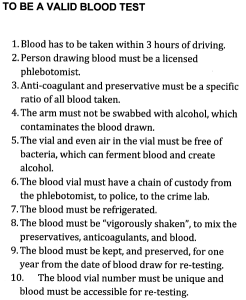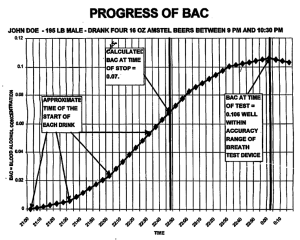DUI Blood Tests and Defenses
This article examines DUI Blood Test and Defenses. A blood test result is not the last word in a DUI case. Many people simply accept blood test results in a DUI case and never question that they might be incorrect. DUI blood test defenses exist, and only among the best Orange County DUI Defense Lawyers will seek them out and assert them. With a blood test, all of the following has to be valid for the blood to even be used in a DUI case. This is true no matter how high the blood test result.
Requirements for a Valid Blood Test
- The blood has to be taken within three (3) hours of driving.
- The person drawing the blood must be a licensed phlebotomist.
- The anticoagulant, and the important preservatives in the blood, which are usually pre-measured, must be a specific ratio of the blood taken in the vial.
- The arm must NOT be swabbed with alcohol, which contaminates the blood was drawn (and thus the entire sample).
- The vial and even the air in the blood vial must be free of bacteria, which can ferment blood and create alcohol.
- The blood vial must have a chain of custody, from the phlebotomist that drew the blood to the police collecting it, to the crime lab testing it.
- Blood must be refrigerated.
- The blood must be “vigorously shaken” to mix the blood with the preservatives and anticoagulants.
- Blood must be kept, and preserved, for one year for retesting by the defense.
- Blood vials must have a unique number, and the blood must be available for re-testing.
How Are Common Improper Blood Tests?
Unfortunately, violations of these important principles, which are made law in Title 17 of the California Administrative Law, are all too common. This important law sets up the requirements of both breath testing, and blood testing, for DUI cases.
The purpose of the alcohol testing laws is to make sure that uncertainty is minimized. Blood or breath testing in a DUI case always tries avoids factors that lead to uncertain results.
For number one above, the three-hour rule, the reason is to avoid speculation regarding the blood alcohol level at the time of driving when doing a retrograde extrapolation, which itself has many problems depending on the factors used.
Example: Rising Blood Alcohol Case
In the example chart below, a person had several drinks and was still absorbing alcohol before being stopped for DUI. The chart shows that, based upon the drinking pattern, the person would have been below the limit when driving. However, it also shows them above the legal limit of .08 later on when the actual testing took place. This is the rising blood alcohol defense.
Case Results: Blood Test Case Dismissed
Example: Our law firm recently won a dismissal of a DUI case. An alleged second-time DUI offender with a blood test showed a .27% blood alcohol level. When we requested the blood for retesting from the Orange County Crime Lab Forensic Alcohol Division, which we do in every blood case, the crime lab reported that they could not find the vial. Two vials had the same printed number, and the names were close to each other but different. There was no way to know which blood vial corresponded to each defendant, so the case was dismissed.
Just the fact that we challenged the blood test in the first place and asked for the blood vial to be re-tested, caused a dismissal of the DUI. Our forensic alcohol expert normally uses an independent lab with an independent gas chromatograph, to retest for alcohol levels. However, in this case, just the request was enough for the DUI charge and the case (and probation violation) to be completely dismissed. A blood test result is never the last word in a DUI case.
Contact us: If you have questions about a blood test in a DUI case, or about DUI defenses for blood testing, contact our office anytime. We can be reached also at (949) 682-5316.




